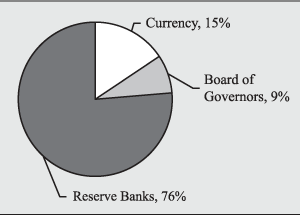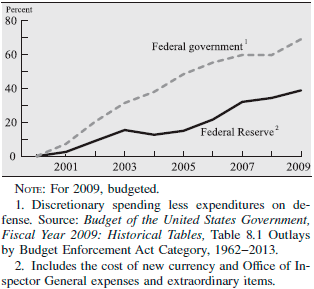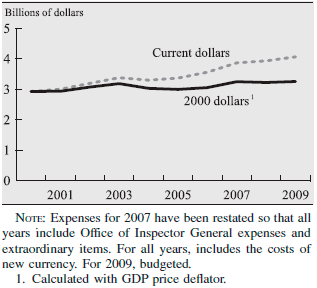Budgets: Chapter 1. Federal Reserve System
Total net expenses for the Federal Reserve System for 2009 are budgeted at $4,084.4 million, an increase of 5.5 percent from 2008 actual expenses. Of this total, $3,086.2 million is for the Reserve Banks, $366.7 million is for the Board of Governors, and $631.5 million is for the cost of new currency (tables 1.1 and 1.2).1 Revenue from priced services provided to depository institutions is expected to total $692.4 million, or 17 percent of total budgeted expenses. This revenue, combined with claims for reimbursement and other income, results in the recovery of 28 percent of the System's budgeted 2009 expenses.2 When these items are deducted from budgeted 2009 expenses, net expenses of the System are 15.5 percent higher than 2008 net expenses (table 1.1), primarily because of a decline in priced services revenue and an increase in currency costs.The distribution of budgeted expenses is similar to that in previous years, with the Reserve Banks' expenses accounting for 76 percent of the total, new currency expenses accounting for 15 percent, and Board expenses accounting for the remainder (chart 1.1).
System employment is budgeted at 20,018 for 2009, a decrease of 727 from the 2008 level, largely because of planned staff reductions by the Reserve Banks.
| Item | 2007 (actual) |
2008 (actual) |
2009 (budgeted) |
Percent change | |
|---|---|---|---|---|---|
| 2007 to 2008 | 2008 to 2009 | ||||
| Total System expenses1 | 3,883.02 | 3,872.4 | 4,084.4 | -0.3 | 5.5 |
| Less | |||||
| Revenue from priced services | 1,012.4 | 873.8 | 692.4 | -13.7 | -20.8 |
| Other income | 1.4 | 1.3 | 1.3 | -9.5 | 0.0 |
| Claims for reimbursement3 | 458.2 | 461.1 | 461.7 | 0.6 | 0.1 |
| Equals | |||||
| Net System expenses | 2,411.12 | 2,536.2 | 2,929.0 | 5.2 | 15.5 |
Note: Components may not sum to totals and may not yield percentages shown because of rounding. Total expenses reflect all redistributions for support and overhead and exclude capital outlays.
1. With this 2009 Annual Report: Budget Review, there has been a change in the way expenses are presented: the costs of printing and transporting currency, and related expenses, are now included in total System expenses, to align with the presentation in the Board's 2008 Annual Report. Relevant figures for 2007 and 2008 also include currency expenses, which in past reports were shown as a memo item. Return to table
2. Restated to include Office of Inspector General expenses and extraordinary items. Return to table
3. Costs of fiscal agency and depository services provided to the U.S. Treasury, other government agencies, and other fiscal principals that are billed to these agencies. Return to table
| Item | 2007 (actual) |
2008 (actual) |
2009 (budgeted) |
Percent change | |
|---|---|---|---|---|---|
| 2007 to 2008 | 2008 to 2009 | ||||
| Reserve Banks1 | 2,983.5 | 3,020.8 | 3,086.2 | 1.3 | 2.2 |
| Personnel | 2,013.7 | 2,021.3 | 2,102.4 | 0.4 | 4.0 |
| Nonpersonnel | 969.8 | 999.5 | 983.8 | 3.1 | -1.6 |
| Board of Governors2 | 323.53 | 351.2 | 366.7 | 8.6 | 4.4 |
| Personnel | 237.13 | 268.2 | 274.1 | 13.1 | 2.2 |
| Nonpersonnel | 86.43 | 83.0 | 92.6 | -3.9 | 11.6 |
| Currency4 | 576.0 | 500.4 | 631.5 | -13.1 | 26.2 |
| Total System expenses | 3,883.03 | 3,872.4 | 4,084.4 | -0.3 | 5.5 |
Note: Expenses exclude capital outlays. Components may not sum to totals and may not yield percentages shown because of rounding.
1. For detailed information on Reserve Bank expenses, see chapter 3. Return to table
2. Includes extraordinary items and expenses of the Office of Inspector General. See also chapter 2. Return to table
3. Restated to include Office of Inspector General expenses and extraordinary items. Return to table
4. For more information on currency expenses, see chapter 4. Return to table
Chart 1.1Distribution of Budgeted Expenses of the Federal Reserve System, 2009

d
2009 System Budget Initiatives
The Reserve Bank budgets are funding increases in the central bank functions, specifically monetary policy and public programs, supervision and regulation functions, and cash operations, offset by reductions in the check operations. The major factors affecting the 2009 Reserve Bank budgets are outlined in more detail in chapter 3.
Trends in Expenses and Employment
From the actual 2000 level to the budgeted 2009 amount, the total expenses of the Federal Reserve System have increased an average of 3.8 percent per year (1.2 percent per year when adjusted for inflation) (chart 1.2). Over the same period, nondefense discretionary spending by the federal government has increased an average of 6.0 percent per year (chart 1.3). Over the 2000-2009 period, Federal Reserve System employment has decreased 4,853 (chart 1.4).
Cumulative Change in Federal Reserve System Expenses and Federal Government Expenses, 2000-2009

d
Employment in the Federal Reserve System, 2000-2009

d
The primary factors influencing both Reserve Bank spending restraint and the substantial staffing decreases over the past 10 years have been restructuring efforts in the check-processing function and efficiency measures in the support and overhead functions. Over the same ten-year period, check costs decreased an average of 4.3 percent and the staffing level declined an average of 11.9 percent annually as a result of increased efficiencies and investments in technology. Local support and overhead costs increased an average of 1.6 percent annually and the staffing level dedeclined an average of 3.9 percent annually over the same ten-year period.
2009 Capital Budgets
The capital budgets for the Reserve Banks and the Board total $550.3 million, with $519.4 million budgeted for the Reserve Banks and Federal Reserve Information Technology (FRIT) and $30.9 million budgeted for the Board. As in previous years, the 2009 capital budgets include funding for projects that support the strategic direction outlined by the individual Reserve Banks, System business leaders, and the Board. These strategic goals focus on investments that continue to improve operational efficiencies, enhance services to bank customers, and ensure a safe, high-quality work environment. More detailed discussions of the Board and Reserve Bank capital budgets are included in chapters 2 and 3, respectively.
Footnotes- The Board of Governors budgets on a two-year cycle; in this chapter, 2009 values shown for the System and the Board reflect the estimated second-year effect of the Board's 2008-09 budget. Return to text
- Claims for reimbursement refers to costs of fiscal agency and depository services provided to the U.S. Treasury, other government agencies, and other fiscal principals that are billed to these agencies. Other income comes from services provided on behalf of the U.S. Treasury that are paid for by the depository institutions using the services, which include the transfer of funds between depository institutions and the Treasury. Return to text


 Previous
Previous
